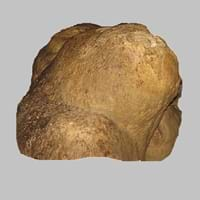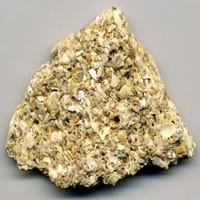Travertine and Coquina
Definition
Definition
Travertine is a mineral consisting of layered calcium carbonate formed by deposition from spring waters
Coquina is a sedimentary rock that is composed either wholly or almost entirely of the transported, abraded, and mechanically-sorted fragments of the shells of molluscs, trilobites, brachiopods, or other invertebrates
History
Origin
Italy
European Foreland Basins
Discoverer
Marcus Vitruvius Pollio
Unknown
Etymology
From Italian travertino a kind of building stone, from Tiburs, adjective from Tibur (Tivoli), in Italy
From Concha (Latin)+ Coquina(Spanish) +conch(English)= Couquina (mid 19th century)
Class
Sedimentary Rocks
Sedimentary Rocks
Sub-Class
Durable Rock, Medium Hardness Rock
Durable Rock, Soft Rock
Family
Group
Not Applicable
Not Applicable
Other Categories
Fine Grained Rock, Opaque Rock
Coarse Grained Rock, Opaque Rock
Texture
Texture
Banded
Clastic
Color
Beige, Black, Blue, Brown, Grey, Red, White, Yellow
Beige, Buff, Orange
Maintenance
Less
More
Durability
Durable
Non-Durable
Water Resistant
Yes
No
Scratch Resistant
Yes
No
Stain Resistant
Yes
No
Wind Resistant
Yes
No
Acid Resistant
Yes
No
Appearance
Fibrous
Layered, Banded, Veined and Shiny
Uses
Architecture
Interior Uses
Decorative Aggregates, Entryways, Flooring, Homes, Interior Decoration
Decorative Aggregates, Homes, Hotels, Interior Decoration
Exterior Uses
As Building Stone, As Facing Stone, Paving Stone, Garden Decoration, Office Buildings
Garden Decoration, Office Buildings
Other Architectural Uses
Curbing
Curbing
Industry
Construction Industry
As Dimension Stone, Building houses or walls, Cement Manufacture, Construction Aggregate, for Road Aggregate, Raw material for the manufacture of mortar
Building houses or walls, Construction Aggregate
Medical Industry
Not Yet Used
Not Yet Used
Antiquity Uses
Artifacts, Jewellery, Monuments, Sculpture, Small Figurines
Artifacts, Monuments, Sculpture, Small Figurines
Other Uses
Commercial Uses
Cemetery Markers, Creating Artwork, Gemstone, Jewelry, Paper Industry, Pottery
Creating Artwork
Types
Types
Not Available
Not Available
Features
Stalactites and stalagmites are formed from this rock, Surfaces are often shiny, Very fine grained rock
Available in Lots of Colors and Patterns, Is one of the oldest rock
Archaeological Significance
Monuments
Used
Used
Famous Monuments
Colosseum in Rome, Italy, Sacré Coeur in Paris, France, Trevi Fountain in Rome, Italy
Data Not Available
Sculpture
Used
Used
Famous Sculptures
Data Not Available
Data Not Available
Pictographs
Used
Used
Petroglyphs
Used
Used
Figurines
Used
Used
Fossils
Present
Present
Formation
Formation
Travertine is a type of sedimentary rock formed when a river carries or transports pieces of broken rock which then undergo sedimentation. They are then subjected to high temperature and pressure hence forming travertine rock.
Coquina is a sedimentary rock which is formed when billions of small clam-like seashell, called Coquina, or cockleshell are die and hence are deposited, buried and turns into a rock when pressure is applied.
Composition
Mineral Content
Calcite, Clay, Feldspar, Micas, Quartz
Apatite, Augite, Bronzite, Calcite, Chert, Chlorite, Clay Minerals, Epidote, Feldspar, Garnet, Micas, Muscovite or Illite
Compound Content
Ca, NaCl, CaO, Oxygen
CaO, Carbon Dioxide, Iron(III) Oxide, MgO
Transformation
Metamorphism
No
No
Types of Metamorphism
Not Applicable
Not Applicable
Weathering
Yes
Yes
Types of Weathering
Biological Weathering, Chemical Weathering, Mechanical Weathering
Biological Weathering, Chemical Weathering, Mechanical Weathering
Erosion
Yes
Yes
Types of Erosion
Chemical Erosion, Coastal Erosion, Glacier Erosion
Coastal Erosion, Sea Erosion, Water Erosion, Wind Erosion
Properties
Physical Properties
Hardness
3-4
1-2
Grain Size
Fine Grained
Coarse Grained
Fracture
Splintery
Irregular
Streak
White
White
Porosity
Highly Porous
Highly Porous
Luster
Dull to Pearly
Dull to Vitreous to Submetallic
Compressive Strength
80.00 N/mm2
23
Not Available
Cleavage
Non-Existent
Not Available
Toughness
1
Not Available
Specific Gravity
1.68
1.10-2.24
Transparency
Opaque
Opaque
Density
2.71 g/cm3
2.8-2.9 g/cm3
Thermal Properties
Specific Heat Capacity
1.09 kJ/Kg K
8
Not Available
Resistance
Impact Resistant, Pressure Resistant, Wear Resistant
Heat Resistant, Impact Resistant, Pressure Resistant, Wear Resistant
Reserves
Deposits in Eastern Continents
Asia
China, Russia
Not Yet Found
Africa
Not Yet Found
Not Yet Found
Europe
Austria, Italy, Portugal, United Kingdom
United Kingdom
Others
Not Yet Found
Not Yet Found
Deposits in Western Continents
North America
Canada, USA
USA
South America
Argentina, Bolivia, Ecuador
Not Yet Found
Deposits in Oceania Continent
Australia
Not Yet Found
Not Yet Found
All about Travertine and Coquina Properties
Know all about Travertine and Coquina properties here. All properties of rocks are important as they define the type of rock and its application. Travertine and Coquina belong to Sedimentary Rocks.Texture of Travertine is Banded whereas that of Coquina is Clastic. Travertine appears Fibrous and Coquina appears Layered, Banded, Veined and Shiny. The luster of Travertine is dull to pearly while that of Coquina is dull to vitreous to submetallic. Travertine is available in beige, black, blue, brown, grey, red, white, yellow colors whereas Coquina is available in beige, buff, orange colors. The commercial uses of Travertine and Coquina are cemetery markers, creating artwork, gemstone, jewelry, paper industry, pottery.
|
||
|
||
|










